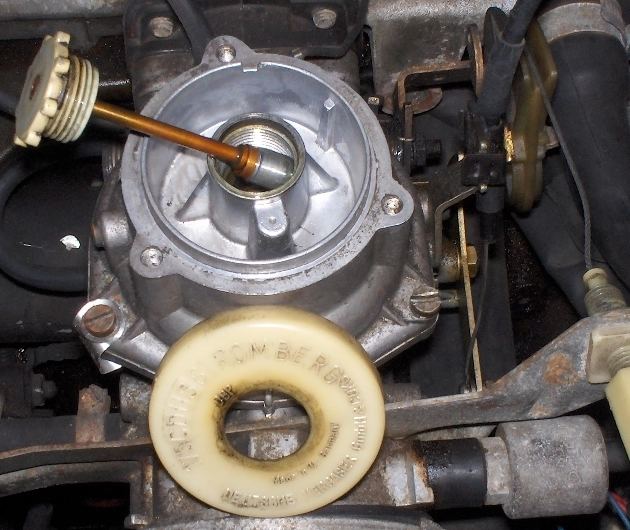 | ||
A dashpot is a mechanical device, a damper which resists motion via viscous friction. The resulting force is proportional to the velocity, but acts in the opposite direction, slowing the motion and absorbing energy. It is commonly used in conjunction with a spring (which acts to resist displacement). The process and instrumentation diagram (P&ID) symbol for a dashpot is .
Contents
Types
Two common types of dashpots exist - linear and rotary. Linear dashpots are generally specified by stroke (amount of linear displacement) and damping coefficient (force per velocity). Rotary dashpots will have damping coefficients in torque per angular velocity.
A less common type of dashpot is an eddy current damper, which uses a large magnet inside a tube constructed of a non-magnetic but conducting material (such as aluminium or copper). Like a common viscous damper, the eddy current damper produces a resistive force proportional to velocity.
Dashpots frequently use a one-way mechanical bypass to permit fast unrestricted motion in one direction and slow motion using the dashpot in the opposite direction. This permits, for example, a door to be opened quickly without added resistance, but then to close slowly using the dashpot. For hydraulic dashpots this unrestricted motion is accomplished using a one-way check-valve that allows fluid to bypass the dashpot fluid constriction. Non-hydraulic dashpots may use a ratcheting gear to permit free motion in one direction.
Applications
A dashpot is a common component in a door closer to prevent it from slamming shut. A spring applies force to close the door, and the dashpot forces fluid to flow through an orifice between reservoirs (the orifice is often adjustable), which slows the motion of the door.
Consumer electronics often use dashpots where it is undesirable for a media access door or control panel to suddenly pop open when the door latch is released. The dashpot provides a steady, gentle motion until the access door has fully opened.
Dashpots are commonly used in dampers and shock absorbers. The hydraulic cylinder in an automobile shock absorber is a dashpot. They are also used on carburetors, where the return of the throttle lever is cushioned just before the throttle fully closes, then is allowed to fully close slowly to reduce emissions. The British SU carburettor's main piston carries a stepped needle. This needle is held in the fuel flow orifice. The manifold vacuum causes this piston to rise allowing more fuel into the airflow. The SU's dashpot has a fixed hydraulic piston, damping the main piston as it moves upward. A valve in the piston disables the damping as the main piston returns.
Large forces and high speeds can be controlled by dashpots. For example, they are used to arrest the steam catapults on aircraft carrier decks.
Relays can be made to have a long delay by utilizing a piston filled with fluid that is allowed to escape slowly. Electrical switchgear may use dashpots in their overcurrent sensing mechanism to reduce reaction speed to brief events, thus making them less sensitive to false-triggering during transients whilst still remaining sensitive to sustained overloads. Another use is for delaying the closing or opening of an electrical circuit. Such a dashpot timer might be used for example for timed staircase lighting.
Anti stall mechanism in internal combustion engines are aimed to prevent the stalling of engine at low rpm. Anti stall mechanisms use Dashpots to arrest the final closing movement of the throttle.
Viscoelasticity
Dashpots are used to form models of materials that exhibit viscoelastic behavior, such as muscle tissue. Maxwell and Kelvin–Voigt models of viscoelasticity use springs and dashpots in series and parallel circuits respectively. Models containing dashpots add a viscous, time dependent, element to the behavior of solids allowing complex behaviors like creep and stress relaxation to be modeled.
